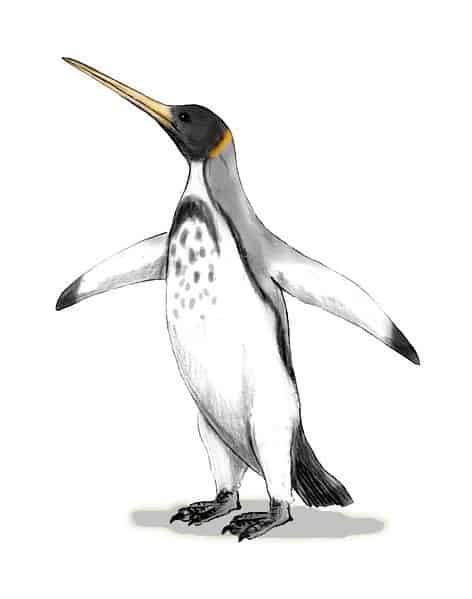When we think of penguins, what comes to mind are small, flightless birds that generally only live in cold areas. Despite penguins always being portrayed as cold-weather birds, only four species live in cold climates. Today there are 14 species of penguins that live in temperate or warm climates. It was previously believed that penguins evolved near the poles and only moved toward the equator about 10 million years ago. However, the discovery of the fossil species Icadyptes has changed that.
Today, the largest known penguins are emperor penguins, which can grow up to 3.5 feet tall. While this may seem big, prehistoric penguins are known to have grown to almost double that height. There are several species of giant penguins that lived millions of years ago, but today, we are going over the Icadyptes. Now, let’s meet the man-sized penguins that once roamed the earth.
Icadyptes — The Man-Sized Penguins

Evidence suggests that
Icadypteswere much larger than penguins as we know them today.
©tya.studio/Shutterstock.com
Icadyptes is an extinct genus of giant penguins that lived about 36 million years ago. Fossils suggest that these penguins grew to be larger than modern-day penguins. They reached a height of about 4.5 to 5 feet tall. On average they weighed between 110 to 175 pounds.
These penguins had very long beaks that look similar to that of a heron, and it is believed most prehistoric penguins had long beaks similar to this. The skeletons found of the Icadyptes indicate that this aquatic bird was built for diving in marine habitats. The bones of this species are more solid than those of flying birds and their wings are much less paddle-like than those of modern-day penguins.
Diet and Habitat
The Icadyptes‘ long beak and skeletal structure were perfect tools for diving and getting nutrient-rich sea life in marine habitats. Because of where their fossils have been discovered, it is now known that they roamed the coasts of ancient South America, diving in the warm water to fish. The Icadyptes were members of the order Sphenisciformes, which are still around today. However, unlike today’s members of Sphenisciformes, these prehistoric penguins lived much closer to the equator in a much warmer climate. The only modern Spheniscidae known to thrive in a similar climate is the Galapagos penguins.
Fossils and Discoveries of the Icadyptes
The first Icadyptes fossils were discovered from marine rocks that belonged to the Otuma Formation in the coastal desert of Peru. Due to the bones of this penguin being more solid than most other birds, they have been very well preserved. The wings of the Icadyptes are solid, like the rest of the skeleton. The wing fossils discovered from this species, in fact, are almost fully intact. Fossils of this species are so well preserved in comparison to other species that the Icadyptes have one of the most intact penguin skeletons ever found.
Within the scientific community, it was previously thought that all penguins evolved in the north and south poles and only migrated closer to the equator about 10 million years ago. However, due to the location of where the Icadyptes and other giant penguin species were found, that timeline has changed. Because of these fossil findings, it is now believed that prehistoric penguins moved toward warmer climates about 30 million years earlier than previously thought.
Time Period and Extinction of the Icadyptes

Change in the earth’s climate at the time likely contributed to the extinction of the
Icadyptes.
©Nobu Tamura (http://spinops.blogspot.com), CC BY 3.0, via Wikimedia Commons – License
Living approximately 37 to 35 million years ago, the man-sized penguins, Icadyptes, were alive during the Late Eocene. During this time period, the climate was much warmer than today’s and the ice around the poles had not yet formed. Vast areas around the globe, including Antarctica, were covered in lush rainforests. The warm oceans were teeming with fish and other sea life making it easy for the Icadyptes to eat and grow to enormous sizes.
Around 35 to 34 million years ago, a drop in carbon dioxide caused a period of global cooling. Before this, the earth was relatively ice-free. When the global cooling began, ice started to form in Antarctica. The drastic change in temperature impacted marine life as well as the animals that lived in the once subtropical climates. The loss of marine life and cooling temperatures are likely the cause of the Icadyptes extinction. This also likely affected other prehistoric giant penguin species.
The penguins of today face a similar issue to the Icadyptes, as the earth’s climate has begun to change. As temperatures get warmer across the world, it can cause the habitats of many penguins to degrade. Species like the emperor penguins can have their habitat disappear within the next 100 years due to melting ice.
What’s Next…
Enjoyed this article? Check out these other great reads from the AZ Animals team that cover penguins, and other water birds.
- Discover the 51 Extinct Penguin Species
- 10 Incredible Penguin Facts
- Discover The Gigantic New Zealand ‘Waterbird’ From 60 Million Years Ago
- The 10 Largest Penguins In The World
The photo featured at the top of this post is © tya.studio/Shutterstock.com
Thank you for reading! Have some feedback for us? Contact the AZ Animals editorial team.






